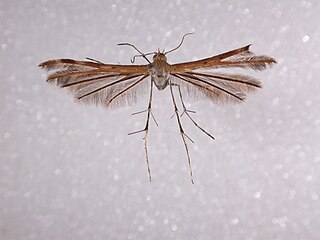
The Pterophoridae or plume moths are a family of Lepidoptera with unusually modified wings. Though they belong to the Apoditrysia like the larger moths and the butterflies, unlike these they are tiny and were formerly included among the assemblage called "microlepidoptera".

Gillmeria ochrodactyla is a moth of the family Pterophoridae. It is found in most of Europe and has recently been recorded from Iran and Tajikistan.

Stenoptilia pterodactyla is a moth of the family Pterophoroidea. It is found in Europe, North America, Anatolia, Iran and China.

Emmelina monodactyla is a moth of the family Pterophoridae. It is found in Europe, Japan, central Asia, North Africa and North America.

Megalorhipida leucodactyla is a species of moth of the family Pterophoridae that has a pantropical distribution.

Stenoptilia zophodactylus is a species of moth of the family Pterophoridae. It is found in Europe, North America, South America, Australia, South Africa, India and Iran.

Gillmeria pallidactyla is a moth of the family Pterophoridae. It has a Holarctic distribution and is widespread throughout North America and Eurasia.

Lantanophaga pusillidactyla, the lantana plume moth, is a moth of the family Pterophoridae. It is native to the southern United States, Mexico, the Caribbean and South America. It was introduced to Australia accidentally in 1936 and is now found from Sydney to Cairns along the coast. It has also been introduced to Hawaii in 1902, Pohnpei in 1948 and Palau in 1960 for biological control. It has since been recorded from Yap in 1987–1988 and is now distributed on all islands of the Mariana and Caroline Islands where the host plant is found, except Aguijan.

Hepalastis pumilio is a moth of the family Pterophoridae. It has worldwide tropical distribution, including Argentina, Brazil, Colombia, Costa Rica, Cuba, Ecuador, Guadeloupe, Jamaica, Mexico, Puerto Rico, Suriname, Japan, Micronesia, South Africa the Virgin Islands as well as Queensland and New Guinea.
Stenoptilodes taprobanes is a moth of the family Pterophoridae. This species has a pantropical distribution, which extends into subtropical areas.

Pterophorus albidus is a moth of the family Pterophoridae. It is distributed in Africa, south and south-east Asia, including New Guinea and Australia, as well as Japan (Kyushu) and the Ryukyu Islands.
Lioptilodes albistriolatus is a moth of the family Pterophoridae. In South America and Central America it has been recorded from Argentina, Brazil, Chile, Costa Rica, Cuba, Ecuador, Guatemala, Paraguay, Peru and Puerto Rico. It is also present in North America, where it is known from Mexico, California, Texas, New Mexico and Arizona. It is an introduced species in Hawaii.
Emmelina argoteles is a moth of the family Pterophoridae. It is found in southern and central Europe, through Russia to India, China, Korea and Japan. It was discovered in Great Britain in 2005.

Adaina microdactyla is a moth of the family Pterophoridae. It has a wide distribution and is known from the Palearctic ecozone, Asia Minor, Iran, Vietnam, the Solomon Islands, the Philippines, Sri Lanka, Indonesia and Papua New Guinea. It is also found in Africa, including the Democratic Republic of the Congo and Madagascar.

Megalorhipida is a genus of moths in the family Pterophoridae described by Hans Georg Amsel in 1935. Species in this genus are distributed in pantropical and subtropical climates. The species typically nests on host plants in the families Nyctaginaceae, Amaranthaceae, Fabaceae, Goodeniaceae, Asteraceae, and Verbenaceae. The generic name is often misspelled as Megalorrhipida. The species formerly placed in the genus Antarches are now considered to belong to this genus.
Exelastis montischristi is a species of moth in the genus Exelastis known from Hispaniola, Ecuador, Grenada, Jamaica, Martinique, the Virgin Islands, Florida and Texas. It has also been recorded from Tanzania.
Singularia is a genus of moths in the family Pterophoridae. It includes all species formerly placed in the genus Chocophorus and five new species described in 2016.
Bipunctiphorus dimorpha is a moth of the family Pterophoridae. The species was first described by Thomas Bainbrigge Fletcher in 1910. It is known from the Seychelles, South Africa, Kenya, Réunion, Madagascar and Tanzania. It has also been recorded from China.

Oidaematophorus eupatorii, the eupatorium plume moth or Joe Pye plume moth, is a moth of the family Pterophoridae. It is found in North America, including Florida, Mississippi, Iowa, New York, California and Vancouver Island. It is also known from Mexico, Guatemala and Panama.
Cees Gielis is a Dutch entomologist and researcher of biodiversity, specializing in Lepidoptera, at the Naturalis Biodiversity Center in Leiden, Netherlands. As of March 2019, Gielis authored 378 taxa within the family of Pterophoridae and 19 within the family of Alucitidae.












